当前位置:
X-MOL 学术
›
Br. J. Cancer
›
论文详情
Our official English website, www.x-mol.net, welcomes your
feedback! (Note: you will need to create a separate account there.)
A direct comparison of selective BH3-mimetics reveals BCL-XL, BCL-2 and MCL-1 as promising therapeutic targets in neuroblastoma.
British Journal of Cancer ( IF 6.4 ) Pub Date : 2020-03-18 , DOI: 10.1038/s41416-020-0795-9 Annika Bierbrauer 1 , Maureen Jacob 1 , Meike Vogler 1 , Simone Fulda 1, 2, 3
British Journal of Cancer ( IF 6.4 ) Pub Date : 2020-03-18 , DOI: 10.1038/s41416-020-0795-9 Annika Bierbrauer 1 , Maureen Jacob 1 , Meike Vogler 1 , Simone Fulda 1, 2, 3
Affiliation

|
BACKGROUND
Despite advances in the treatment of neuroblastoma, patients with high-risk disease still have dismal survival prognosis. Neuroblastoma cells display elevated expression of the antiapoptotic BCL-2 proteins, suggesting that BH3-mimetics may be a promising treatment option. Here, we investigated the role of BCL-2, BCL-XL and MCL-1 in neuroblastoma.
METHODS
A panel of neuroblastoma cell lines and primary patient-derived cells were exposed to BH3-mimetics targeting BCL-2 (ABT-199), BCL-XL (A1331852) or MCL-1 (S63845). In addition, protein expression and interaction patterns were analysed using Western blotting and immunoprecipitation.
RESULTS
All tested BH3-mimetics were able to induce apoptosis in neuroblastoma cell lines, indicating that not only BCL-2 but also BCL-XL and MCL-1 may be promising therapeutic targets. Primary patient-derived cells displayed highest sensitivity to A1331852, highlighting the important role of BCL-XL in neuroblastoma. Further analysis into the molecular mechanisms of apoptosis revealed that A1331852 and S63845 displaced proapoptotic proteins like BIM and BAK from their antiapoptotic targets, subsequently leading to the activation of BAX and BAK and caspase-dependent apoptosis.
CONCLUSIONS
By using selective BH3-mimetics, this study demonstrates that BCL-2, BCL-XL, and MCL-1 are all relevant therapeutic targets in neuroblastoma. A1331852 and S63845 induce rapid apoptosis that is initiated following a displacement of BAK from BCL-XL or MCL-1, respectively.
中文翻译:

选择性 BH3 模拟物的直接比较表明 BCL-XL、BCL-2 和 MCL-1 是神经母细胞瘤的有希望的治疗靶点。
背景尽管神经母细胞瘤的治疗取得了进展,但患有高危疾病的患者的生存预后仍然很差。神经母细胞瘤细胞显示抗凋亡 BCL-2 蛋白的表达升高,这表明 BH3 模拟物可能是一种有前途的治疗选择。在这里,我们研究了 BCL-2、BCL-XL 和 MCL-1 在神经母细胞瘤中的作用。方法 将一组神经母细胞瘤细胞系和原发性患者衍生细胞暴露于靶向 BCL-2 (ABT-199)、BCL-XL (A1331852) 或 MCL-1 (S63845) 的 BH3 模拟物。此外,使用蛋白质印迹和免疫沉淀分析蛋白质表达和相互作用模式。结果 所有测试的 BH3 模拟物都能够在神经母细胞瘤细胞系中诱导细胞凋亡,这表明不仅 BCL-2,而且 BCL-XL 和 MCL-1 都可能是有希望的治疗靶点。原代患者来源的细胞对 A1331852 表现出最高的敏感性,突出了 BCL-XL 在神经母细胞瘤中的重要作用。对细胞凋亡分子机制的进一步分析表明,A1331852 和 S63845 将 BIM 和 BAK 等促凋亡蛋白从其抗凋亡靶标中置换出来,随后导致 BAX 和 BAK 的激活以及半胱天冬酶依赖性细胞凋亡。结论 通过使用选择性 BH3 模拟物,本研究表明 BCL-2、BCL-XL 和 MCL-1 都是神经母细胞瘤的相关治疗靶点。A1331852 和 S63845 分别诱导 BAK 从 BCL-XL 或 MCL-1 置换后开始的快速细胞凋亡。对细胞凋亡分子机制的进一步分析表明,A1331852 和 S63845 将 BIM 和 BAK 等促凋亡蛋白从其抗凋亡靶标中置换出来,随后导致 BAX 和 BAK 的激活以及半胱天冬酶依赖性细胞凋亡。结论 通过使用选择性 BH3 模拟物,本研究表明 BCL-2、BCL-XL 和 MCL-1 都是神经母细胞瘤的相关治疗靶点。A1331852 和 S63845 分别诱导 BAK 从 BCL-XL 或 MCL-1 置换后开始的快速细胞凋亡。对细胞凋亡分子机制的进一步分析表明,A1331852 和 S63845 将 BIM 和 BAK 等促凋亡蛋白从其抗凋亡靶标中置换出来,随后导致 BAX 和 BAK 的激活以及半胱天冬酶依赖性细胞凋亡。结论 通过使用选择性 BH3 模拟物,本研究表明 BCL-2、BCL-XL 和 MCL-1 都是神经母细胞瘤的相关治疗靶点。A1331852 和 S63845 分别诱导 BAK 从 BCL-XL 或 MCL-1 置换后开始的快速细胞凋亡。和 MCL-1 都是神经母细胞瘤的相关治疗靶点。A1331852 和 S63845 分别诱导 BAK 从 BCL-XL 或 MCL-1 置换后开始的快速细胞凋亡。和 MCL-1 都是神经母细胞瘤的相关治疗靶点。A1331852 和 S63845 分别诱导 BAK 从 BCL-XL 或 MCL-1 置换后开始的快速细胞凋亡。
更新日期:2020-04-24
中文翻译:

选择性 BH3 模拟物的直接比较表明 BCL-XL、BCL-2 和 MCL-1 是神经母细胞瘤的有希望的治疗靶点。
背景尽管神经母细胞瘤的治疗取得了进展,但患有高危疾病的患者的生存预后仍然很差。神经母细胞瘤细胞显示抗凋亡 BCL-2 蛋白的表达升高,这表明 BH3 模拟物可能是一种有前途的治疗选择。在这里,我们研究了 BCL-2、BCL-XL 和 MCL-1 在神经母细胞瘤中的作用。方法 将一组神经母细胞瘤细胞系和原发性患者衍生细胞暴露于靶向 BCL-2 (ABT-199)、BCL-XL (A1331852) 或 MCL-1 (S63845) 的 BH3 模拟物。此外,使用蛋白质印迹和免疫沉淀分析蛋白质表达和相互作用模式。结果 所有测试的 BH3 模拟物都能够在神经母细胞瘤细胞系中诱导细胞凋亡,这表明不仅 BCL-2,而且 BCL-XL 和 MCL-1 都可能是有希望的治疗靶点。原代患者来源的细胞对 A1331852 表现出最高的敏感性,突出了 BCL-XL 在神经母细胞瘤中的重要作用。对细胞凋亡分子机制的进一步分析表明,A1331852 和 S63845 将 BIM 和 BAK 等促凋亡蛋白从其抗凋亡靶标中置换出来,随后导致 BAX 和 BAK 的激活以及半胱天冬酶依赖性细胞凋亡。结论 通过使用选择性 BH3 模拟物,本研究表明 BCL-2、BCL-XL 和 MCL-1 都是神经母细胞瘤的相关治疗靶点。A1331852 和 S63845 分别诱导 BAK 从 BCL-XL 或 MCL-1 置换后开始的快速细胞凋亡。对细胞凋亡分子机制的进一步分析表明,A1331852 和 S63845 将 BIM 和 BAK 等促凋亡蛋白从其抗凋亡靶标中置换出来,随后导致 BAX 和 BAK 的激活以及半胱天冬酶依赖性细胞凋亡。结论 通过使用选择性 BH3 模拟物,本研究表明 BCL-2、BCL-XL 和 MCL-1 都是神经母细胞瘤的相关治疗靶点。A1331852 和 S63845 分别诱导 BAK 从 BCL-XL 或 MCL-1 置换后开始的快速细胞凋亡。对细胞凋亡分子机制的进一步分析表明,A1331852 和 S63845 将 BIM 和 BAK 等促凋亡蛋白从其抗凋亡靶标中置换出来,随后导致 BAX 和 BAK 的激活以及半胱天冬酶依赖性细胞凋亡。结论 通过使用选择性 BH3 模拟物,本研究表明 BCL-2、BCL-XL 和 MCL-1 都是神经母细胞瘤的相关治疗靶点。A1331852 和 S63845 分别诱导 BAK 从 BCL-XL 或 MCL-1 置换后开始的快速细胞凋亡。和 MCL-1 都是神经母细胞瘤的相关治疗靶点。A1331852 和 S63845 分别诱导 BAK 从 BCL-XL 或 MCL-1 置换后开始的快速细胞凋亡。和 MCL-1 都是神经母细胞瘤的相关治疗靶点。A1331852 和 S63845 分别诱导 BAK 从 BCL-XL 或 MCL-1 置换后开始的快速细胞凋亡。











































 京公网安备 11010802027423号
京公网安备 11010802027423号